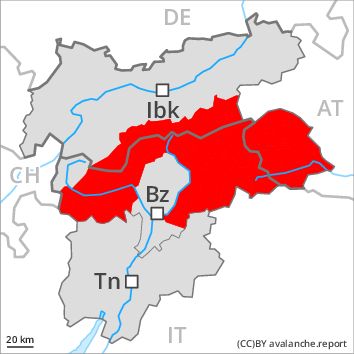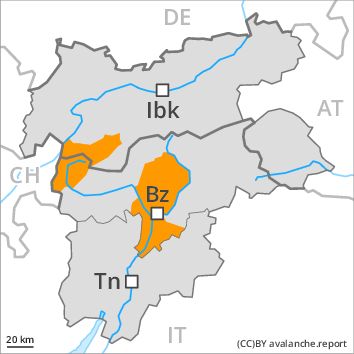Regions
Sexten Dolomites, Eastern Pfunderer Mountains, Durreck Range, Western Rieserferner Mountains, Gurgler Range, Western Deferegger Alps, Central Stubai Alps, Ortler Range, Schnals Ridge, Northern Zillertal Alps, Southern Stubai Alps, Ulten Valley, Venediger Range, Southern Zillertal Alps and High Tauern, Eastern Rieserferner Mountains, Saldurn-Mastaun Ridge, Glockner Range, Texel Mountains, Gröden Dolomites, Eastern Deferegger Alps, Prags Dolomites, Schober Mountains, Western Pfunderer Mountains, Lienzer Dolomites

Danger level
Avalanche Problem
Gliding snow above 2500m, N-NE-E-SE-S-SW-W-NW
Wind-drifted snow above 2200m, N-NE-E-SE-S-SW-W-NW

Gliding snow represents the main danger. Fresh wind slabs require caution, in particular above approximately 2200 m.
Numerous natural avalanches have been released as a consequence of fresh snow and stormy weather.
On steep grassy slopes more gliding avalanches are possible, even quite large ones, in the regions exposed to heavier precipitation especially, in particular in the east.
In addition the extensive wind slabs of the last few days above approximately 2200 m are prone to triggering. These can be released, even by a single winter sport participant and reach large size in isolated cases. The prevalence of avalanche prone locations and likelihood of triggering will increase with altitude. As a consequence of the sometimes strong southerly wind more natural avalanches are possible, even very large ones in isolated cases, in particular in shady places that are protected from the wind at high altitudes and in high Alpine regions.
Snow sport activities outside marked and open pistes call for extensive experience in the assessment of avalanche danger.
Snowpack
dp 2: gliding snow
dp 6: cold, loose snow and wind
Over a wide area 50 to 80 cm of snow, and up to 120 cm in some localities, fell. The wind was strong to storm force. In some places wind slabs are lying on soft layers, especially at elevated altitudes. The fresh wind slabs are in many cases thick and can in some cases be released easily especially at their margins. The snowpack will be wet all the way through at low and intermediate altitudes.
Tendency
The avalanche danger will persist.
